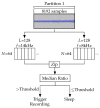Deploying Acoustic Detection Algorithms on Low-Cost, Open-Source Acoustic Sensors for Environmental Monitoring
- PMID: 30699950
- PMCID: PMC6387379
- DOI: 10.3390/s19030553
Deploying Acoustic Detection Algorithms on Low-Cost, Open-Source Acoustic Sensors for Environmental Monitoring
Abstract
Conservation researchers require low-cost access to acoustic monitoring technology. However, affordable tools are often constrained to short-term studies due to high energy consumption and limited storage. To enable long-term monitoring, energy and space efficiency must be improved on such tools. This paper describes the development and deployment of three acoustic detection algorithms that reduce the power and storage requirements of acoustic monitoring on affordable, open-source hardware. The algorithms aim to detect bat echolocation, to search for evidence of an endangered cicada species, and also to collect evidence of poaching in a protected nature reserve. The algorithms are designed to run on AudioMoth: a low-cost, open-source acoustic monitoring device, developed by the authors and widely adopted by the conservation community. Each algorithm addresses a detection task of increasing complexity, implementing extra analytical steps to account for environmental conditions such as wind, analysing samples multiple times to prevent missed events, and incorporating a hidden Markov model for sample classification in both the time and frequency domain. For each algorithm, we report on real-world deployments carried out with partner organisations and also benchmark the hidden Markov model against a convolutional neural network, a deep-learning technique commonly used for acoustics. The deployments demonstrate how acoustic detection algorithms extend the use of low-cost, open-source hardware and facilitate a new avenue for conservation researchers to perform large-scale monitoring.
Keywords: acoustics; bioacoustics; conservation; ecology; machine learning.
Conflict of interest statement
The authors declare no conflict of interest.
Figures












Similar articles
-
Bat detective-Deep learning tools for bat acoustic signal detection.PLoS Comput Biol. 2018 Mar 8;14(3):e1005995. doi: 10.1371/journal.pcbi.1005995. eCollection 2018 Mar. PLoS Comput Biol. 2018. PMID: 29518076 Free PMC article.
-
NEAL: an open-source tool for audio annotation.PeerJ. 2023 Aug 25;11:e15913. doi: 10.7717/peerj.15913. eCollection 2023. PeerJ. 2023. PMID: 37645015 Free PMC article.
-
Ecological inferences about marine mammals from passive acoustic data.Biol Rev Camb Philos Soc. 2023 Oct;98(5):1633-1647. doi: 10.1111/brv.12969. Epub 2023 May 4. Biol Rev Camb Philos Soc. 2023. PMID: 37142263 Review.
-
Windy events detection in big bioacoustics datasets using a pre-trained Convolutional Neural Network.Sci Total Environ. 2024 Nov 1;949:174868. doi: 10.1016/j.scitotenv.2024.174868. Epub 2024 Jul 19. Sci Total Environ. 2024. PMID: 39034006
-
Automatic detection for bioacoustic research: a practical guide from and for biologists and computer scientists.Biol Rev Camb Philos Soc. 2025 Apr;100(2):620-646. doi: 10.1111/brv.13155. Epub 2024 Oct 17. Biol Rev Camb Philos Soc. 2025. PMID: 39417330 Free PMC article. Review.
Cited by
-
Development of an Artificial Neural Network Algorithm Embedded in an On-Site Sensor for Water Level Forecasting.Sensors (Basel). 2022 Nov 5;22(21):8532. doi: 10.3390/s22218532. Sensors (Basel). 2022. PMID: 36366229 Free PMC article.
-
To Bag or Not to Bag? How AudioMoth-Based Passive Acoustic Monitoring Is Impacted by Protective Coverings.Sensors (Basel). 2023 Aug 20;23(16):7287. doi: 10.3390/s23167287. Sensors (Basel). 2023. PMID: 37631823 Free PMC article.
-
Computational bioacoustics with deep learning: a review and roadmap.PeerJ. 2022 Mar 21;10:e13152. doi: 10.7717/peerj.13152. eCollection 2022. PeerJ. 2022. PMID: 35341043 Free PMC article. Review.
-
High-sensitivity narrow‑band T-shaped cantilever Fabry-perot acoustic sensor for photoacoustic spectroscopy.Photoacoustics. 2024 Jun 8;38:100626. doi: 10.1016/j.pacs.2024.100626. eCollection 2024 Aug. Photoacoustics. 2024. PMID: 38966593 Free PMC article.
-
MeLa: A Programming Language for a New Multidisciplinary Oceanographic Float.Sensors (Basel). 2020 Oct 26;20(21):0. doi: 10.3390/s20216081. Sensors (Basel). 2020. PMID: 33114608 Free PMC article.
References
-
- Browning E., Gibb R., Glover-Kapfer P., Jones K.E. Conservation Technology: Acoustic Monitoring. WWF; Woking, UK: 2017. Technical Report.
-
- Astaras C., Linder J.M., Wrege P.H., Orume R.D., Macdonald D.W. Passive acoustic monitoring as a law enforcement tool for Afrotropical rainforests. Front. Ecol. Environ. 2017;15:233–234. doi: 10.1002/fee.1495. - DOI
Grants and funding
LinkOut - more resources
Full Text Sources
Other Literature Sources

